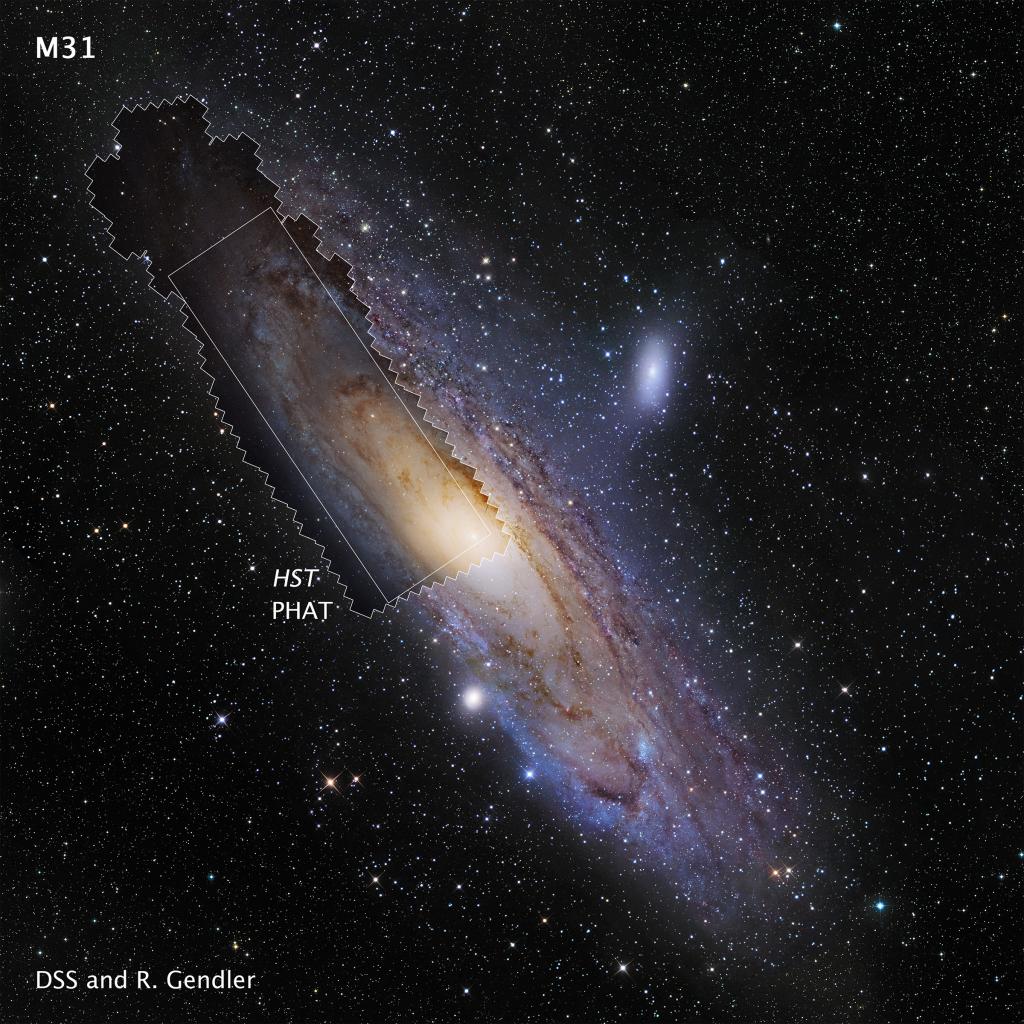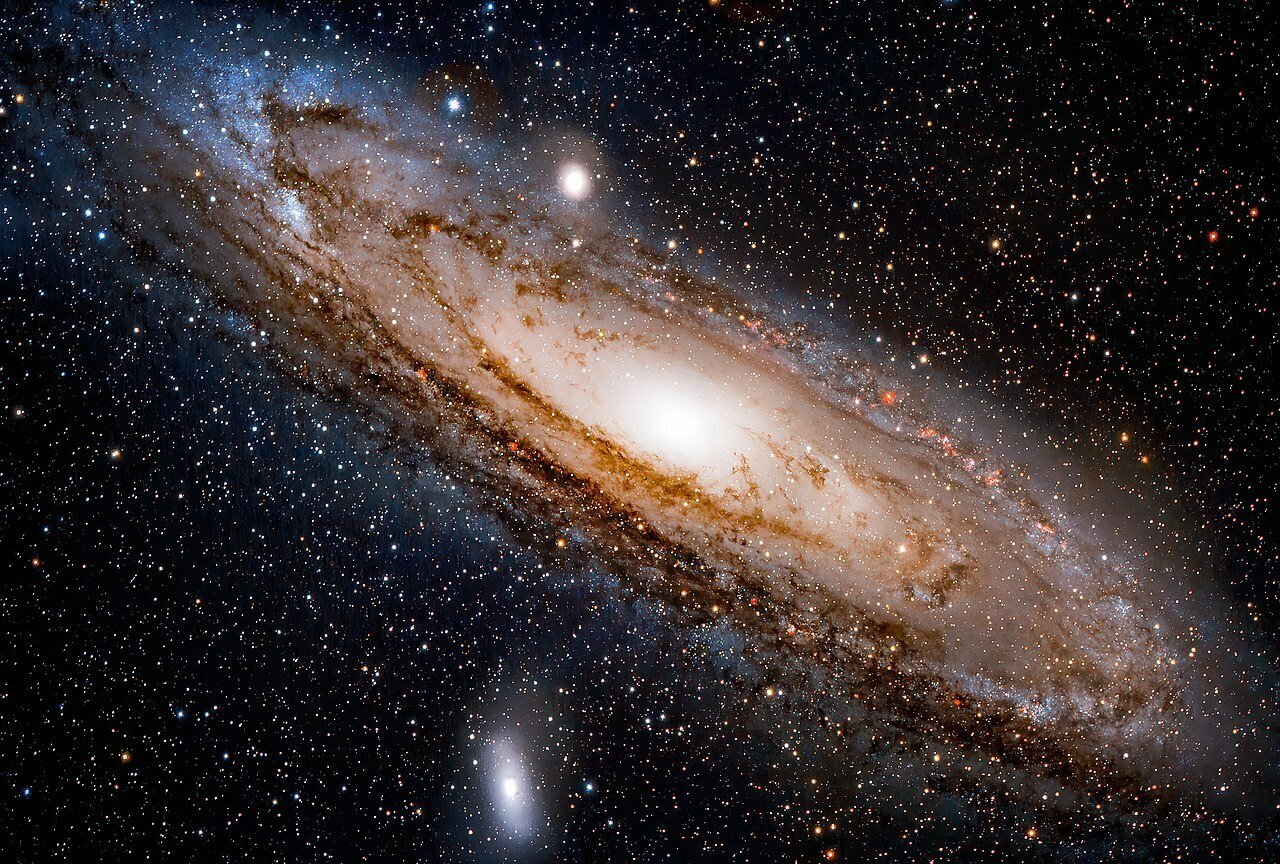Since ancient times, scientists have been attracted to the Andromeda galaxy. Some of the earliest documents date back to the 10th century. Until the early 1900s, the Andromeda galaxy was thought to be a nebula within the Milky Way galaxy. It was widely assumed that our galaxy held the entirety of the cosmos.
However, there were early 17th-century theories concerning the presence of extragalactic objects, most notably by a French mathematician named Pierre Louis Maupertuis. He imagined “island universes” with their stars, planets, and other celestial bodies, which he described as “beautiful and fairly true.” Later, in his treatise Universal Natural History and Theory of the Heavens, the well-known German philosopher Immanuel Kant mentioned him.
The stars of Andromeda were viewed in conjunction with the stars of Pisces to form a goddess of fertility in ancient Greece and Rome. “Al Hut” — a fish — was seen by the Arabic astronomers. Stargazers in ancient China saw different legends in the stars of Andromeda, including a great commander and mansions for their monarchs. The stars of Andromeda, Cassiopeia, and Triangulum are linked together as a porpoise in the south Pacific when these constellations are low on the horizon.
Heber Curtis (1872-1942) observed a nova in the Andromeda “nebula” in 1917. Curtis was sure that Andromeda was a galaxy similar to the Milky Way Galaxy after studying earlier novae, including those in the Milky Way Galaxy. He also believed that the dust lanes discovered in Andromeda were comparable to those seen in the Milky Way Galaxy. Edwin Hubble (1889-1953) answered that question a few years later, proving that “nebulae” like Andromeda were in fact galaxies based on his studies and observations.
⫸ WHAT IS ANDROMEDA GALAXY?
The Andromeda Galaxy is possibly the most beautiful object in our galaxy. It has an intriguing name that means “island collector” due to its repeated appearances as a smudge of light when viewed through binoculars or small telescopes, but it can also be seen with just your eyesight alone!
This spiral galaxy appears like the milky way except much larger because each star streaks away from us at different speeds giving them sort of separate identities instead of being crowded together tight as we see here on Earth where everything seems far away.
The galaxy is so large that it takes light almost 20 years to get from one end of the space station- like our own Milky Way! It has been estimated that this particular group contains some 100 billion stars, with each star holding up several planets in their habitable zones where life could potentially exist.
From the Northern Hemisphere, the Andromeda Galaxy is the only galaxy visible without a telescope. It appears as a faint, fuzzy patch in the sky from a dark location, and it is easy to spot with binoculars. The Andromeda is seen in the autumn sky. To find it, use a sky chart to locate the constellation Andromeda, and then look for it in the sky. It’s close to Pegasus’s huge square.
The Andromeda galaxy, our Milky Way’s closest neighbor, is the farthest object in the sky that can be seen with the naked eye – but only on a clear night from a dark location. The galaxy is a lovely spiral, but there’s one detail you might not know: we’re safe for a few billion years, but Andromeda is on its path to collide with the Milky Way.
Because of its relative closeness to Earth — approximately 2.5 million light-years distant — Andromeda is an ideal target for extrapolating information about other spiral galaxies. In recent years, scientists have conducted extensive research on black holes, stars, and other galactic objects. The Hubble Space Telescope captured a magnificent mosaic of Andromeda galaxy photos in 2015.
⫸ LOCATION OF ANDROMEDA GALAXY:
The constellation Andromeda returns to the night skies between September and October. Andromeda is a fascinating deep-sky object and the subject of intriguing historical legends, despite not being the most visible constellation in the sky. Look for the W-shaped constellation Cassiopeia in the northern sky to locate constellation Andromeda.
Andromeda is positioned close to Cassiopeia and is linked to a boxy form of stars that make up the Pegasus constellation. All viewers in the northern hemisphere can see Andromeda, as well as many, but not all, spectators south of the equator.
Look for the W-shaped constellation Cassiopeia in the northern sky to locate the constellation, Andromeda. Andromeda is positioned close to Cassiopeia and is linked to a boxy form of stars that make up the Pegasus constellation. All viewers in the northern hemisphere can see Andromeda, as well as many, but not all, spectators south of the equator.
⫸ FACTS ABOUT ANDROMEDA GALAXY:
- And Andromeda may not be the most massive galaxy in the Local Cluster, despite its size. More dark matter is thought to be present in the Milky Way, which might make it considerably larger.
Astronomers use the Andromeda Galaxy to learn about the origin and evolution of spiral galaxies since it is the closest spiral galaxy to us.
- At a speed of 100 to 140 kilometers per second, the Andromeda Galaxy is nearing the Milky Way.
- The Andromeda Galaxy’s twin nucleus is extremely dense. It not only features a large star cluster at its center, but it also has at least one supermassive black hole at its core.
- Gravitational interactions with two neighboring galaxies, M32 and M110, are distorting the spiral arms of the Andromeda Galaxy.
- There are at least two spiral arms in the Andromeda Galaxy, as well as a ring of dust that may have come from the smaller galaxy M32. Astronomers believe it interacted more closely with Andromeda several hundred million years ago when M32 smashed into the larger neighbor’s heart.
- There are at least 450 globular clusters in and around the Andromeda Galaxy. They’re among the most densely crowded globulars I’ve ever seen.
⫸ HOW MANY STARS ARE THERE IN ANDROMEDA GALAXY?
The Andromeda Galaxy has around one trillion stars, whereas the Milky Way Galaxy has approximately 250 billion stars. The Andromeda Galaxy, or M31, is our Milky Way’s nearest major companion, yet it is 2.5 million light-years away. As a result, it is the farthest object that can be seen with the naked eye regularly.

The Andromeda Galaxy has one trillion stars, according to some estimates. It is more than 200,000 light-years in diameter. That’s a lot bigger than the Milky Way, which, according to more current estimates, is 150,000 light-years across (though the exact boundary of where either of these galaxies “end” is a bit nebulous). Astronomers are still trying to figure out how many stars our galaxy has, but it appears to contain about a quarter to a half as many as Andromeda.
⫸ HOW TO FIND ANDROMEDA GALAXY IN THE NIGHT SKY?
Discover the majestic Andromeda galaxy by taking a night drive to a dark sky spot. It’s the massive spiral galaxy that lies next to our Milky Way and is the farthest object visible to the human eye. It’s best visible in the evenings this time of year.
Star-hopping from Cassiopeia the Queen, a large M- or W-shaped pattern on the sky’s dome, is the most popular way to find the galaxy. The Andromeda galaxy can also be found by star-hopping from Pegasus’ Great Square’s star Alpheratz. Both methods will lead you to the universe’s center.
Because they are so easy to point, binoculars are an ideal choice for beginners looking to observe the Andromeda galaxy. Locate the galaxy with your eye first as you stand beneath a dark sky. Then slowly raise the binoculars to your eyes so that you can see the galaxy through them. If it doesn’t work, try using your binoculars to sweep the area. Slow down and double-check if your eyes are dark-adapted. To the naked eye, the galaxy will seem like a hazy area. Binoculars will make it appear brighter.
⫸ CAN ANDROMEDA GALAXY SUPPORT LIFE?
So far, it appears that intelligent alien life — at least in the restricted sense of the term — has not been discovered. Despite decades of efforts to make our existence known and converse with advanced alien civilizations, theories and assumptions abound as to why we have yet to make contact with or see proof of them.
It’s even more difficult to say if there might be life, or at least the circumstances for life, in another galaxy because we can’t say for sure whether there are any other stars in our galaxy that support life.
Nonetheless, the Andromeda Galaxy is very similar to our own, and we know of at least one star in the Milky Way that can support life as we know it.
The Milky Way has between 100 and 400 billion stars, thus statistically, out of the trillion or so stars in the Andromeda Galaxy, there should be up to a dozen or so stars with habitable planets.
⫸ CONCLUSION:
The Andromeda galaxy will collide with the Milky Way in around 4.5 billion years, unlike other galaxies in our cosmic neighborhood that are moving away from us at an accelerating rate due to cosmic expansion. It’s speeding towards the Milky Way at 110 kilometers per second. In about 6 billion years, this massive collision will most likely result in a larger spiral galaxy.
The two supermassive black holes at the center of each galaxy will collide and combine at the center of the newly created galaxy, potentially resulting in a powerful quasar that fires high-energy particles perpendicular to the galaxy’s plane. The shock wave created by the merging of the two black holes could lead to an increase in new star formation.
The Andromeda galaxy is one of the most fascinating objects in space. It’s no wonder that people have been trying to find out more about it for centuries. What do you think is the coolest thing about Andromeda? Let us know in the comments below. And be sure to share this article with your friends and family who love learning about astronomy!

